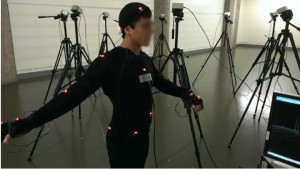
Courtesy Art
Reporter
A new motion-capture laboratory being set up at Baylor will soon help bio-mechanists treat walking disabilities and develop devices to monitor the body status of patients.
The laboratory will be similar to those used for producing animations, where actors put markers all over their bodies and have their movements reconstructed in the computer, said Dr. Jonathan Rylander, assistant professor of mechanical engineering.
Rylander said he is going to use the lab, housed at the Baylor Research and Innovation Collaborative, for orthopedic clinical studies in which he will assess whether treatments are effective for people who have difficulty walking.
“If you want to make sure that some surgical treatment is actually effective, you can basically test the patient before the surgery and wait until they have the surgery and do another motion-capture test,” he said. “Then you compare the tests to see if the surgery has actually changed something.”
He said this form of assessment is more accurate than a survey, which tends to be biased toward the positive side.
Rylander said he may collaborate with doctors at the Brooke Army Medical Center in San Antonio. They will bring wounded service members and veterans to Waco and assess the effectiveness of surgeries or the function of artificial limbs.
He said some patients will be service members coming back from Iraq or Afghanistan and others will be those hurt during basic training when a sudden workload increase injures their bodies.
Rylander said he is also working on a potential collaboration with doctors at Baylor Scott and White Hillcrest Medical Center.
Dr. Brian Garner, associate professor of mechanical engineering, said he is going to use this new lab for his research on electronic sensors that are put on the body. The sensors can monitor the physiological parameters such as heart rate and blood pressure and send the data to medical caregivers.
“The idea is patients may be at risk of stroke or heart attack, or they are diabetic or elderly and are at a risk of falling,” Garner said. “Their status can be monitored remotely and continuously. If any data starts looking troublesome, it can give an alert to caregivers who can enter in advance and prevent something bad from happening.”
Garner said he may have elderly patients do walking trials in the new lab and monitor their movement patterns as well as the data transmission process.
Rylander said he hopes the lab at the BRIC will be put into use in the coming summer.
Garner said he has done preliminary studies using portable motion-capture devices in the hallway at the BRIC. But the new lab will contain more permanent equipment to make it easier for patients to take the tests.
Garner said he is also developing a dynamic moving service to treat neurological disabilities, including autism. In the treatment derived from horse-riding therapy, patients sit on a device that moves the same way as a live horse. He said he may use the motion-capture lab to assess their improvements.
Rylander said he has worked at motion-capture labs at Stanford University and in San Antonio before joining Baylor this fall. He said he is especially interested in the combination of mechanics and medicine. Setting up the new lab is part of the agreement of his accepting the job here.
“Growing up, I always had a soft spot for medicine,” he said. “When I see somebody who has a really hard time walking, it just gets to me and bothers me. I want to be able to help that person.”





